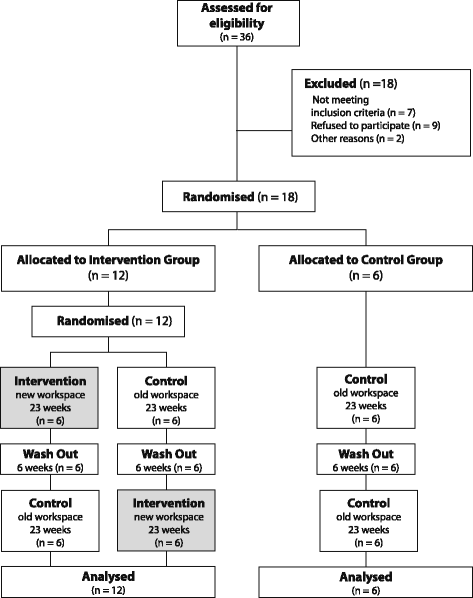Effect of a novel two-desk sit-to-stand workplace (ACTIVE OFFICE) on sitting time, performance and physiological parameters: protocol for a randomized control trial
- PMID: 27422158
- PMCID: PMC4947350
- DOI: 10.1186/s12889-016-3271-y
Effect of a novel two-desk sit-to-stand workplace (ACTIVE OFFICE) on sitting time, performance and physiological parameters: protocol for a randomized control trial
Abstract
Background: Prolonged sitting is ubiquitous in modern society and linked to several diseases. Height-adjustable desks are being used to decrease worksite based sitting time (ST). Single-desk sit-to-stand workplaces exhibit small ST reduction potential and short-term loss in performance. The aim of this paper is to report the study design and methodology of an ACTIVE OFFICE trial.
Design: The study was a 1-year three-arm, randomized controlled trial in 18 healthy Austrian office workers. Allocation was done via a regional health insurance, with data collection during Jan 2014 - March 2015. Participants were allocated to either an intervention or control group. Intervention group subjects were provided with traditional or two-desk sit-to-stand workstations in either the first or the second half of the study, while control subjects did not experience any changes during the whole study duration. Sitting time and physical activity (IPAQ-long), cognitive performance (text editing task, Stroop-test, d2R test of attention), workload perception (NASA-TLX) and physiological parameters (salivary cortisol, heartrate variability and body weight) were measured pre- and post-intervention (23 weeks after baseline) for intervention and control periods. Postural changes and sitting/standing time (software logger) were recorded at the workplace for the whole intervention period.
Discussion: This study evaluates the effects of a novel two-desk sit-to-stand workplace on sitting time, physical parameters and work performance of healthy office based workers. If the intervention proves effective, it has a great potential to be implemented in regular workplaces to reduce diseases related to prolonged sitting.
Trial registration: ClinicalTrials.gov Identifier: NCT02825303 , July 2016 (retrospectively registered).
Keywords: Cognitive performance; Concentration; Office; Postural changes; Reaction time; Sitting; Standing; Stroop-test; Workload; d2R-test of attention.
Figures
References
-
- World Health Organization. Global recommendations on physical activity for health. Switzerland: WHO Press; 2010. p. 1-60. ISBN 978-92-4-159997-9. http://www.who.int/dietphysicalactivity/publications/9789241599979/en/. Accessed 23 Sept 2015.
Publication types
MeSH terms
Substances
Associated data
LinkOut - more resources
Full Text Sources
Other Literature Sources
Medical




